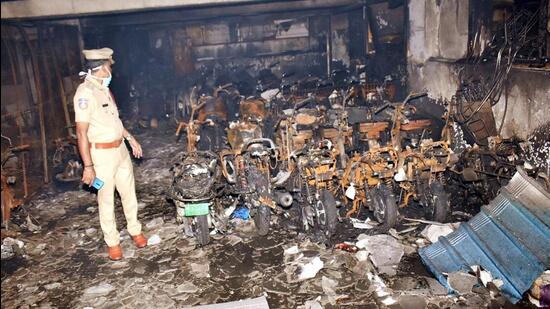The science behind e-scooter fires
As with any electrical device, an electric vehicle comes with its own inherent risks, but is considered safe as long as it has been tested properly and is maintained well and not abused.
The fire in a showroom for electric scooters in Secunderabad, which caused eight deaths, comes in the wake of several instances of e-scooters catching fire across the country. CCTV footage from the showroom showing a battery exploding in one of the scooters, which were reportedly being charged at the time, raises the question: how safe is an e-scooter or, for that matter, any electric vehicle?

As with any electrical device, an electric vehicle comes with its own inherent risks, but is considered safe as long as it has been tested properly and is maintained well and not abused. “EVs are safe as all EVs undergo rigorous safety testing. The challenge of fire and explosion risk in batteries is being addressed by most EV manufacturers with their efficient and intelligent Battery Management Systems (BMS)... The certification agencies, Automotive Research Association of India (ARAI), International Centre for Automotive Technology (ICAT) does rigorous testing for overcharge, short circuit and vibration,” the Bureau of Energy Efficiency under the Ministry of Power says on its website.
But what is it that makes fire and explosion a risk in the batteries of electric vehicles? It is the battery itself, lithium-ion, whose composition makes it both energy-efficient and potentially vulnerable. Lithium-ion batteries are used not only in most electric vehicles, including scooters, but also in common devices such as mobile phones and laptops.
A battery typically comprises a series of cells, each of which contains two terminals of opposite charge (positive and negative) and an electrolyte —a chemical solution through which charged particles flow, leading to an electric current. A lithium-ion battery involves the flow of lithium particles (ions). Lithium ions are smaller than the ions generated in traditional alkaline batteries, which means the same charge can be carried in a smaller space. As such, a lithium-ion battery packs more energy per unit mass or unit volume. On the other hand, the lithium electrolyte in the battery is extremely flammable, and can overheat easily, sometimes leading to an explosion.
Overheating can be lethal for a lithium-ion battery, and can often be the result of what is known as “thermal runway”. This is a chain reaction within a battery cell: the temperature inside the battery rises high enough to cause a chemical reaction, which in turn produces more heat and causes further reactions, eventually leading to fire.
Given that this is true of any lithium-ion battery, what explains the fact that fires are being reported more frequently in electric scooters than in electric cars? One possible reason could be different technologies used by e-cars and e-scooters for cooling their batteries.
“Electric scooters do not have inbuilt liquid cooling unlike four-wheelers like cars and buses. Rather they are air-cooled which sometimes is not sufficient if the ambient temperature is higher,” said Aravind Kumar Chandiran, assistant professor of chemical engineering at Indian Institute of Technology, Madras.
Besides, he said, battery management systems in cars are tested better than in scooters. “The vehicle battery management system operates batteries based on lab-scale data and relevant models. However, the real-time operation is very different… the battery management system should be designed taking into account real-time operations to avoid such mishaps,” he said.
He noted, however, that electrics cars too “catch fire, but they are well-tested to avoid anticipated issues”.
Another question the Secunderabad fire raises is how significant is the possibility that the e-scooters were being charged at the time. Whether that played a role in the fire or not, it is always risky to overcharge a battery.
“A battery catches fire under three instances — electrical, thermal or mechanical, or under any of these combinations. Overcharging is an issue where we tend to pump more current into the battery than its maximum capacity. During this process, after 100% charging, the current pumped into the device will decompose the battery materials, leading to fire. Overcharging constitutes electrical abuse,” Chandiran said.
“Assume we operate the battery at high temperatures continuously, there is a chance of fire as well. This falls under thermal abuse. Mechanical abuse is related to accidents,” he said.
How should manufacturers go about preventing or minimising such risks? By testing batteries in a real-time scenario, Chandiran said. “Prepare a BMS algorithm associated with this real-time data, then we can safeguard the batteries.”
Get Current Updates on India News, Lok Sabha Election 2024 live, Elections 2024, Election 2024 Date along with Latest News and Top Headlines from India and around the world.




